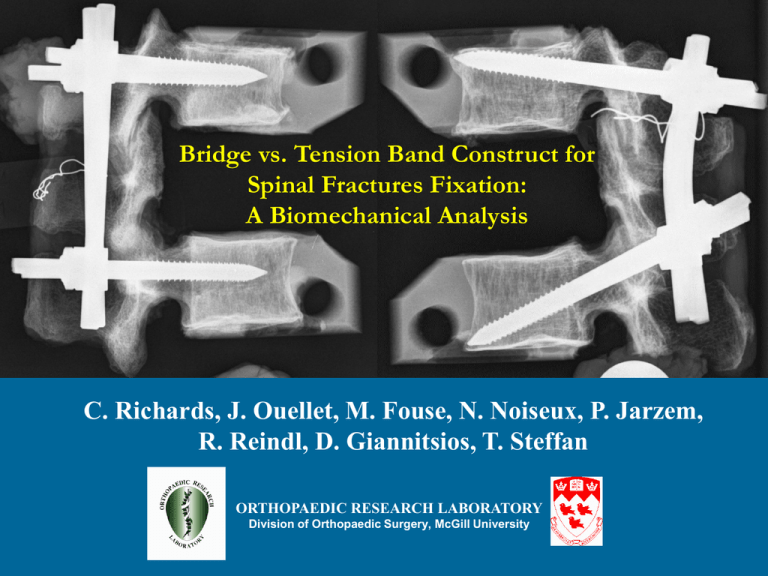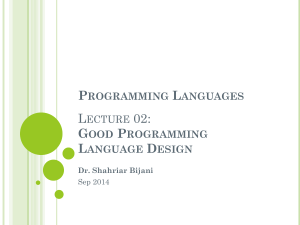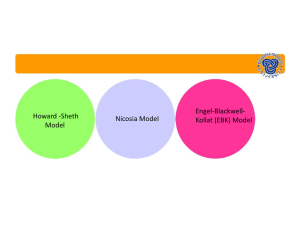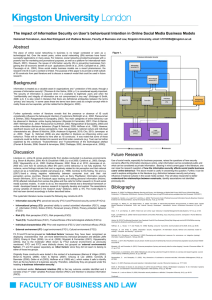Comparison of Pedicle Screw Spinal Fixation for Fractures
advertisement

Bridge vs. Tension Band Construct for Spinal Fractures Fixation: A Biomechanical Analysis C. Richards, J. Ouellet, M. Fouse, N. Noiseux, P. Jarzem, R. Reindl, D. Giannitsios, T. Steffan ORTHOPAEDIC RESEARCH LABORATORY Division of Orthopaedic Surgery, McGill University Problem Traditional pedicle screw instrumentation: Parallel to endplate Kyphotic collapse is a known complication Risk of posterior pullout if not supported anteriorly Hypothesis For spinal fracture fixation bridge-type fixation = divergent screws vs. tension-band = parallel screws Significantly stiffer Better resistance to failure in kyphosis Better resistance to screw pull-out Hypothesis > Hypothesis > Purpose Bridge vs. Tension Band Constructs Construct stiffness Ultimate failure load 800 Ultimate Failure Load 700 600 Load (N) 500 400 Stiffness 300 200 100 0 0 20 40 Displacem ent (m m ) 60 Materials and Methods 1. Finite Element Analysis of ASTM Polyethylene Constructs Methods and Materials 1. 2. Finite Element Analysis of ASTM Polyethylene Constructs Mechanical testing of ASTM Polyethylene Construct Methods and Materials 1. 2. 3. Finite Element Analysis of ASTM Polyethylene Constructs Mechanical testing of ASTM Polyethylene Construct Mechanical testing of Cadaveric Constructs ASTM Corpectomy Model UHMWPE blocks Worst case scenario for vertebral body fracture Followed precisely for T-B Constructs Pedicle screws inserted parallel to horizontal plane ASTM Corpectomy Model Altered for Bridge Constructs Change in pedicle screw orientation w.r.t. horizontal plane 16.5º superiorly 26.4º inferiorly Finite Element Analysis Linear FEA 3-D models of ASTM constructs Mechanical properties of polyethylene and titanium Finite Element Analysis Models loaded at 100N, 300N, & 600N Displacement data generated for each load Polyethylene Construct 6 constructs built 3 TB 3 Bridge Constructs loaded using MTS Load and displacement data generated Cadaveric Constructs 6 male cadavers dissected 3 Matched pairs based on Vertebral body size and BMD instrumented @ T11-L1 3 – TB Construct 3 – Bridge Construct #2 Osteotome Cadaveric Constructs Potted in PMMA Anterosuperior endplate of superior vertebra free Anteroinferior endplate of inferior vertebra free Cadaveric Constructs Loaded using MTS Load and displacement data generated Results – Stiffness (N/mm) 40 34.1 35 Stiffness (N/mm) p=0.015 p=0.012 30 25 21.6 20 17.3 20.6 15.2 18.4 15 10 5 0 FEA Polyethylene Cadavers Results – Ultimate Failure Load 700 p=0.076 Ultimate Failure Load (N) 600 500 419 400 300 200 100 0 622 Results All specimens were evaluated for accuracy and safety of schanz screw insertion Maximum angles as determined by the anatomic study were achieved No breech of pedicle wall Results Pattern of Failure Tension Band Construct All 3 constructs failed into kyphosis Screw pullout at the pedicle-body junction Results Pattern of Failure Bridge Construct 2/3 constructs failed 1. 2. Screw pullout at the pedicle-body junction Screw pullout through superior endplate Discussion Increased stiffness Better protection of anterior column Allows better potential for healing Decrease risk of kyphotic failure Conclusions Bridge Construct is significantly stiffer than the Tension Band Construct Ultimate failure load was 50% greater for the Bridge Construct Further Cadaveric testing is required and is ongoing > Thank You C. Richards, J. Ouellet, M. Fouse, N. Noiseux, P. Jarzem, R. Reindl, D. Giannitsios, T. Steffan ORTHOPAEDIC RESEARCH LABORATORY Division of Orthopaedic Surgery, McGill University









